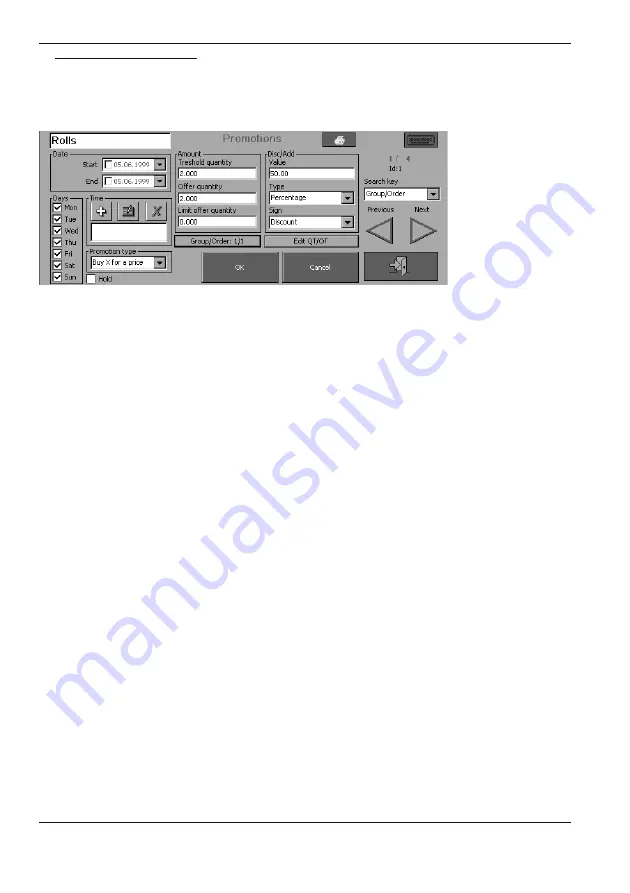
POS–4000
© Elcom, s. r. o.
39
POS programming
Promotion programming
Enter Promotions menu from Programming main icon. For a new promotion, touch
New
button. First, enter name of promotion in box at top left—this is also how it will appear on
the receipt, such as “Product X buy one get one free offer”. (Please remember that there is an
on screen keyboard available by touching the symbol in the top right corner.)
Next enter
Start
date of the promotion and then enter an
End
date of the promotion (tou-
ching the drop down symbol on the right brings up a calendar). You can select which
Days
you wish the promotion to run—by default, all days are entered. If you only wish the promo-
tion to run on certain days uncheck those days when it will not apply. This feature allows you
to have weekend specials for example. You can also select which hours you wish the promo-
tion to run using the
Time
box. If you leave it blank it will run all day or press the
+
button
and you can select which hours. The cross button cancels any entry.
There are two types (pure price discounts are handled under discounts):
• buy certain items get an item(s) free/ at a reduced price (e.g. buy 2 get one free)
• buy items for a special price (e.g. buy 3 for 1)
Select which type it is from the drop down menu.
The check box below
Hold
can stop the promotion if checked. This might be used when one
of the items on the promotion is out of stock.
The
Amount
section refers to the qualifying product to be purchased. The threshold quantity
is the amount the customer has to buy to qualify—so if it is a 2 for 1, 2 is entered. The offer
quantity is what is being offered so if 2 for 1, it is 1. If it is buy 3 items for 1 the threshold
quantity is 3 and the offer quantity is 3. You can limit the number of items (offers) any one
customer can purchase; this should be entered in the
Offer quantity
box. Leave blank if
you do not want a limit.
Group/order
is a slightly complex area that allows you to have multiple promotions on the
same item. An example would be beer where you may have three promotions on the same
product of say, 4 for 5, 8 for 9 and 12 for 12. In this particular case you would assign them
the same group number and then assign:
• the 12 promotion as order1,
• the 8 promotion as order 2
• the 4 promotion as order 3.
The reason for this is best given as an example. Suppose somebody purchased 16 cans. You
would want them to have the 12 offer and then the 4 offer. By assigning the above priorities
the system looks at the 16 cans transaction and identifies that there is a 12 there as its first
check. It then looks for 8 and can’t find any as only 4 cans are left and therefore it applies the
last priority of the 4 can price. Thus, the biggest offer quantity is normally priority (order) 1
running downwards to the smallest offer quantity. Group number can also be used as a pri-
ority sequence, which can be useful if you have a product on several different promotions.
< Figure
3.15
Promotion programming
dialogue
Summary of Contents for POS-4000
Page 1: ...POS 4000 User manual application version 1 85 manual version 1 0 8...
Page 6: ...POS 4000 Elcom s r o...
Page 10: ...POS 4000 Elcom s r o...
Page 22: ...POS 4000 Elcom s r o...
Page 44: ...POS 4000 Elcom s r o...
Page 62: ...POS 3000 Elcom s r o 62 Training mode Figure 6 4 The testing window of the training mode...
Page 64: ...POS 4000 Elcom s r o...
Page 68: ...POS 3000 Elcom s r o 68...
















































